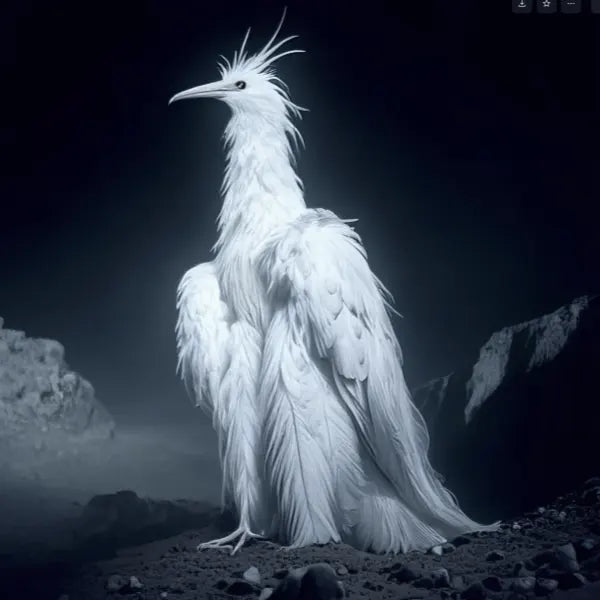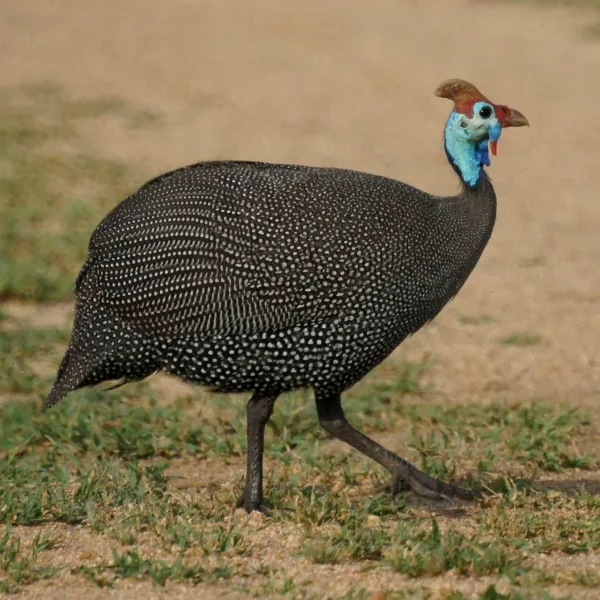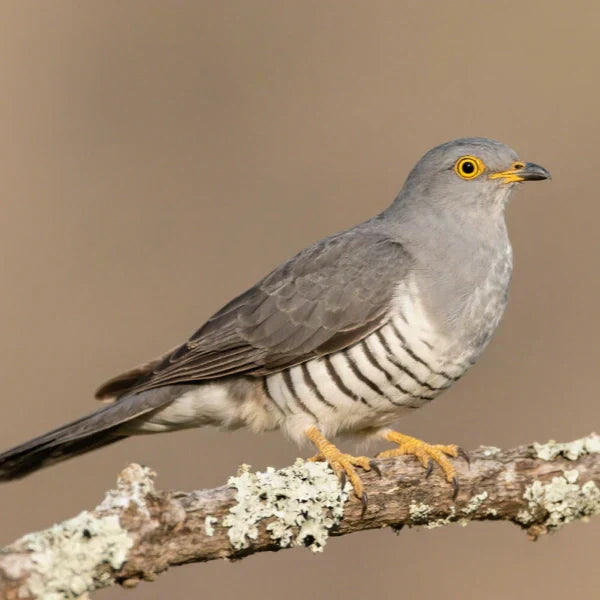Introduction
In late 2023, a distorted video began circulating, showing something vast and feathered marching through a blizzard. It stood 14 feet tall, with matted feathers and eyes that were too dark, almost human. The voice that narrated the video was disturbingly calm. People leaned in and dubbed it the Opium Bird(or Erosion Bird). Of course, some of the details did not quite add up. However, that did not stop the video from spreading like wildfire.
What is interesting is how familiar it sounded. The silence, the mimicry, the unblinking gaze, strange, yes, but not entirely fabricated. In the real world, birds exhibit similar behaviors. So, what is the Opium Bird? A modern myth? A chimera created from nature's most bizarre creatures? In this article, we'll explore the rise of a bird that never existed. Join us as we delve into how TikTok and human imagination brought life to a myth.
A Modern Myth Is Born: AI, TikTok, and the Viral Machine
What is the Opium Bird? The Opium Bird did not emerge from a forgotten manuscript or get whispered in secret through the centuries. It was created in September 2023 by special effects artist Dre VFX using advanced AI tools.
Dre combined video editing overlays with a surreal AI voiceover of Joe Rogan. The voiceover had a detached, clinical, documentary-like quality. It described the creature as a naturally occurring Antarctic animal that was enormous, vocal, and predatory. The combination of slick visual realism and authoritative tone was enough to make people question what they were seeing.
The bird was originally called "Erosion Bird," a fitting description of its dirty, rusted appearance. But within a matter of days, the TikTok community had baptized it with a different name. One user jokingly referred to it as "Opium Bird," a name that caught on in no time. There was something absurd and yet strangely fitting about this name. TikTok's algorithm, designed to shock and arrest attention, was also to blame for the video's popularity.

As the memes grew, so did the backstory. Fan lore ran rampant. Some claimed the Opium Bird was connected with the Willow Project, a real oil drilling project in Alaska. The beast was nature's vengeance, they claimed. Others claimed it was a mutated creature from an abandoned Arctic colony. The colony was called Kali Thanda, a made-up name given credibility by its eerie, unfamiliar sound. Videos surfaced referencing "2027 sightings," speculative timelines, and even alternate "docile" versions from other planets.
One video presented the bird as a fake National Geographic segment, complete with a logo watermark. It showcased slow-motion footage of the creature walking along the ice, appealing to viewers through its aesthetic alone. What began as a digital art project evolved into a form of collaborative folklore.

The Opium Bird, Piece by Piece: Real Birds That Echo the Fiction
If you freeze the video, you can see it in all its glory: the beast is abnormally tall. Its height ranges from 8 to 14 feet, depending on the video you trust. Its body is wrapped in tangled white feathers that seem more like fur than flight. A shaggy mane flows down its back. Its beak angles downward, heavy and hook-like, like a corroded sickle. The monster is a mosaic of features. Let's break down the pieces and the real birds that probably influenced them.

The Tall, Stooped Silhouette: Marabou Stork
The stooping posture and dark silhouette of the Opium Bird are echoed in the Marabou Stork. This bird is often referred to as the "Undertaker Bird" because of its unusual appearance. It can frequently be seen wandering around landfills or areas where corpses may be present, resembling a ghostly figure. Its drooping neck ruff and bald head eerily resemble the ghost appearance of the Opium Bird. If you are interested in learning more about the Marabou Stork, check out our companion piece: Marabou Stork: Africa's Most Misunderstood Bird.

The Shaggy Mane: Philippine Eagle
That wild, mane-like ruff around the neck of the Opium Bird reminds us of the Philippine Eagle's wild crown of feathers. This critically endangered bird of prey possesses a wild aureole of feathers and front-facing piercing eyes. Its regal and elusive appearance contributes to the myth's otherworldly aura.

The Stare: Great Grey Owl & Barn Owl
The Opium Bird's hypnotic gaze is not particularly remarkable. Owls, such as the Great Grey and Barn Owl, have dark, glossy eyes positioned frontally on their heads. Together with their rounded heads and near-silent flight, they convey an unnatural, ghostly serenity. Their unblinking gaze seems wise and contemplative, quite as the legends suggest.

Photo by DSD on Pexels
The Hooked Beak: Shoebill Stork
The Opium Bird has a sickle-shaped, enormous beak. It closely resembles the large beak of the Shoebill Stork. This swamp-dwelling predator sports a shoe-shaped bill large enough to crush flesh.

Photo by Cyrill on Pexels
Voice-Stealing: Lyrebird; Northern Mockingbird
This legend says the Opium Bird mimics voices in order to lure victims. In reality, birds do this in real life. The Lyrebird can imitate chainsaws, camera shutters, and even human speech, so realistically that it deceives our ears. The Northern Mockingbird is known for stringing together dozens of different calls within its habitat. These birds don't just mimic calls; they adopt them like natural tape recorders.

The Antarctic Predator: South Polar Skua
The Opium Bird's environment almost perfectly mirrors the actual range of the South Polar Skua. This aggressive seabird steals from other scavengers and thrives in the harsh conditions of Antarctica. A real-life ice villain.

By Paride Legovini, via Wikimedia Commons, licensed under CC BY-SA 4.0.
The Opium Bird may be fake, but its parts aren't. We already possess creatures that can stare like ghosts, mimic our sounds, and survive in Earth's most remote environments. The hoax works because nature has already performed the hard labor.
Beyond the Hoax: What the Opium Bird Can Teach Us About Conservation
Millions of people are captivated by a bird that doesn't exist. Meanwhile, several remarkable and colorful birds in the real world are vanishing, often quietly without notice.
Consider the Philippine Eagle, one of the largest raptors on Earth, with its ghostly white feathers and intense gaze. This bird has one of the Opium Bird's most haunted features. However, this giant is not a hoax. Only a few hundred remain in the wild, clinging to fragmented rainforests that have been destroyed by logging and agriculture.
Then there's the Shoebill, with an enormous beak that probably inspired the Opium Birds design. It lives in central African wetlands, where habitat loss and the pet trade threaten its survival. Even the Snow Petrel, a real Antarctic bird cloaked in spotless white, struggles to survive. Global warming is rapidly reshaping the icy planet it calls home.

International conservation organizations work to rescue threatened species. BirdLife International organizes bird conservation across continents by surveying Important Bird Areas and bringing partners together to conserve habitats. The IUCN Red List monitors threats to extinction and helps governments prioritize action.
These efforts are dependent on the public interest. Increased awareness leads to donations, while curiosity encourages preservation, as real birds do not need to hypnotize or tower above us to be amazing.

Photo by Tristan Frank on Unsplash
Final Thoughts
The Opium Bird was never real, but it succeeded because it captured our imagination. It drew inspiration from nature, combining the creepiest bits of real birds, and satisfied our hunger for mystery. However, while we chased after a viral hoax, some of the world's most amazing real birds are quietly disappearing.
As AI-generated content becomes increasingly convincing, distinguishing between fact and fiction will become more challenging. That is why we must be curious, but also skeptical. We should ask questions and dig deeper. And as we do, let's not forget the living, breathing birds around us. They don't need to be invented to be magical; they simply need to be saved.

FAQs About the Opium Bird
What is the Opium Bird?
The “Opium Bird,” sometimes called the “Erosion Bird,” is not a real animal. It is a fictional cryptid created in 2023 by digital artist Dre VFX using AI software. It was designed to resemble a ghostly, enormous bird and garnered huge media attention online, especially on TikTok. This colossal avian is reputed to stand at an imposing 14 feet tall, with a gaze that can hypnotize and a presence that spells doom for any who crosses its path.
Is the Opium Bird based on a real bird species?
Not exactly. It incorporates visual and behavioral traits from several real birds, such as the Shoebill, Marabou Stork, and Lyrebird. The blend of familiar and unfamiliar helped sell the deception.
Why did everyone believe the Opium Bird was real?
The Opium Bird featured enough realistic features, with creepy AI photos, a pseudo-documentary format, and vague storytelling. It felt more like a nature mystery than a hoax.
What is the name of the bird that hypnotizes humans?
There is no real bird that can hypnotize humans. The so-called “Opium Bird,” also known as the “Erosion Bird,” is an AI-generated creature that went viral online. Its eerie appearance led people to describe it as hypnotic or mesmerizing, but it does not exist in nature.




Leave a comment
All comments are moderated before being published.
This site is protected by hCaptcha and the hCaptcha Privacy Policy and Terms of Service apply.